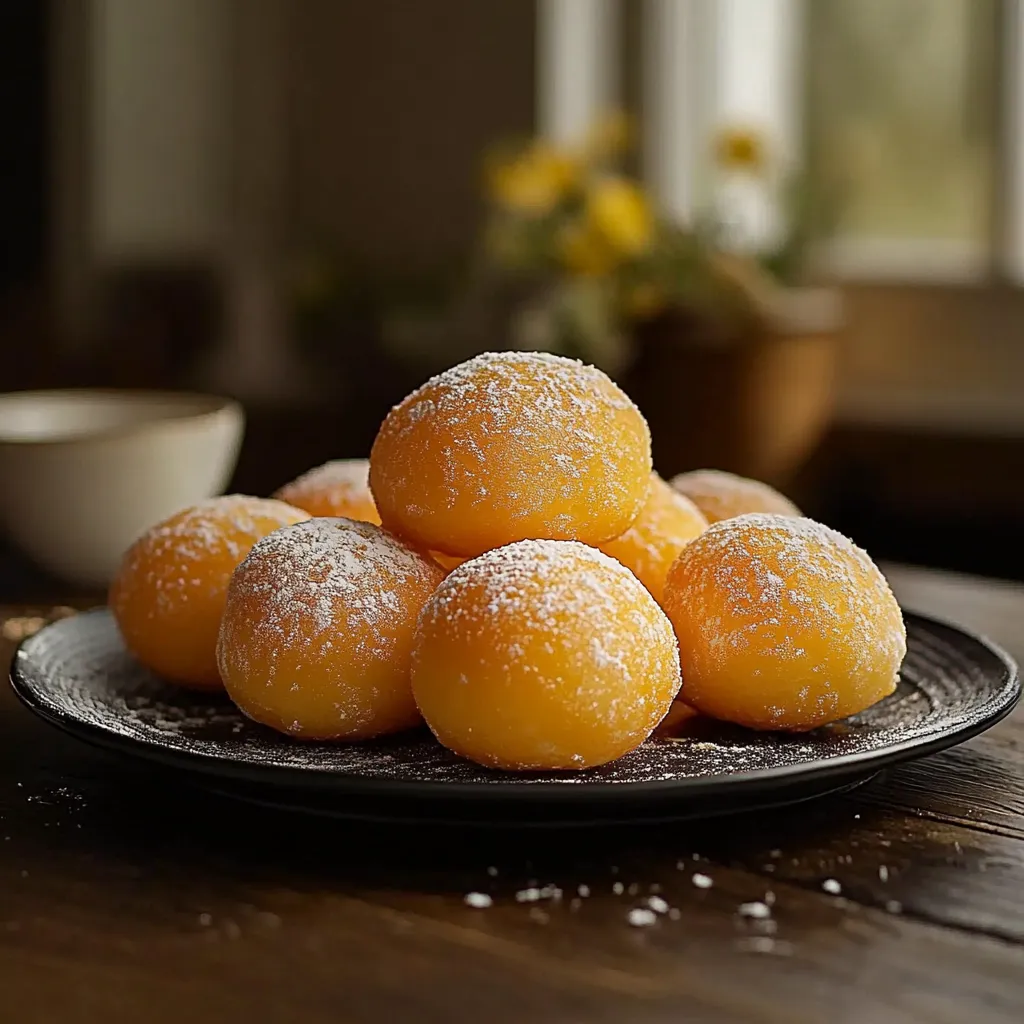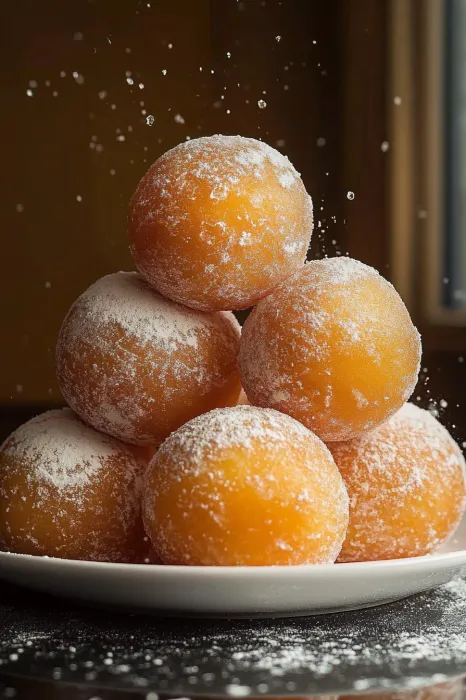 Pin it
Pin it
This hearty Portuguese Malasadas recipe brings the beloved golden doughnuts of Portugal and Hawaii right to your kitchen. These pillowy soft treats with their crispy exterior and sugary coating have been a weekend tradition in my home for years, especially when we have friends over for brunch.
I first discovered malasadas during a trip to Hawaii where I stood in line for almost an hour at Leonard's Bakery. After that first warm, sugary bite, I knew I had to learn how to make them at home.
Ingredients
- All purpose flour: Provides the structure these fluffy doughnuts need
- Granulated sugar: Sweetens the dough perfectly without being overwhelming
- Active dry yeast: Creates that distinctive airy texture inside
- Warm milk: Activates the yeast and adds richness to the dough
- Eggs: Bind everything together and contribute to the tender crumb
- Unsalted butter: Adds richness and helps create that melt in your mouth quality
- Vanilla extract: Provides depth of flavor that complements the sweetness
- Salt: Enhances all the flavors and balances the sweetness
- Vegetable or canola oil for frying: Gives a clean taste and the right crisp exterior
- Extra sugar for coating: Creates that signature sweet finish
Step-by-Step Instructions
- Activate the Yeast:
- Combine warm milk with a teaspoon of sugar and yeast in a bowl. Allow it to rest for 5 to 10 minutes until you see a foamy layer on top. This step is crucial as it ensures your yeast is alive and will create that perfect rise.
- Create the Dough Base:
- In a large bowl, whisk together flour, sugar, and salt. This even distribution of dry ingredients will give your malasadas consistent texture and flavor throughout.
- Combine Wet and Dry Ingredients:
- Add eggs, melted butter, vanilla, and the activated yeast mixture to your dry ingredients. Mix thoroughly until a sticky dough forms. The dough should be tacky but not dry. If too sticky, add a tablespoon of flour at a time.
- First Rise:
- Cover the bowl with a clean kitchen towel and place in a warm, draft-free area. Allow the dough to rise for 1 to 2 hours until doubled in size. This slow rise develops the flavor and texture that makes malasadas special.
- Shape the Doughnuts:
- Punch down the risen dough to release air bubbles then turn onto a lightly floured surface. Divide into 12 equal portions and shape into balls. Let them rest for 15 minutes which relaxes the gluten and makes for tender malasadas.
- Fry to Golden Perfection:
- Heat oil in a deep pot to exactly 175°C. Use a thermometer for accuracy. Carefully drop dough balls into the hot oil, frying 2 to 3 at a time to maintain oil temperature. Cook for 2 to 3 minutes per side until deeply golden brown.
- Drain and Sugar Coat:
- Remove fried malasadas with tongs and place on paper towels briefly to absorb excess oil. While still hot, roll them in granulated sugar to create that signature sweet coating that makes malasadas irresistible.
- Serve Fresh:
- Arrange on a serving plate and enjoy immediately. Malasadas are at their absolute best when fresh and warm, with that perfect contrast between crisp exterior and fluffy interior.
 Pin it
Pin it
My favorite part of making malasadas is watching friends take their first bite. The look of surprise at how light they are despite being fried always makes the effort worthwhile. My Portuguese neighbor once told me these reminded her of her grandmother's recipe, which was the highest compliment.
The Secret to Perfect Texture
The key to achieving that authentic malasada texture lies in the dough consistency and frying temperature. The dough should be tacky but not overly sticky. If your kitchen is particularly humid, you might need to add a bit more flour. Conversely, in dry conditions, you might need less. Trust your intuition about how the dough feels in your hands. The oil temperature is equally crucial. Too cool, and the malasadas absorb excess oil and become greasy. Too hot, and they brown before cooking through. A cooking thermometer is invaluable here.
Traditional Variations
While this recipe presents the classic sugar coated malasada, regional variations abound throughout Portugal and Hawaii. In Madeira, malasadas are traditionally eaten on Terça feira Gorda, the day before Ash Wednesday, to use up sugar and fat before Lent. In Hawaii, they are often filled with haupia, a coconut pudding, or tropical fruit custards like guava or lilikoi. For a mainland American twist, try rolling them in cinnamon sugar or filling with chocolate pastry cream. Each variation maintains the essential fluffy texture while offering different flavor experiences.
Make Ahead Tips
Although malasadas are best fresh, you can prepare the dough up to 24 hours in advance. After mixing, place the dough in a large bowl, cover with plastic wrap, and refrigerate. The cold temperature slows yeast activity while still allowing flavor development. When ready to cook, remove the dough from the refrigerator and let it warm to room temperature for about 30 minutes before shaping. This slow fermentation actually enhances the flavor complexity of the finished malasadas and makes this a perfect prep ahead option for entertaining.
 Pin it
Pin it
Frequently Asked Questions
- → What are malasadas?
Malasadas are Portuguese deep-fried doughnuts—fluffy inside and crisp on the outside, often coated with sugar.
- → How should I store leftover malasadas?
Store leftovers in an airtight container at room temperature for up to 2 days. Warm before serving for the best taste.
- → What type of oil is best for frying malasadas?
Use neutral oils like vegetable or canola oil for frying as they do not overpower the flavor of the doughnuts.
- → Can I refrigerate malasadas?
It is best to avoid refrigeration as it can dry out the malasadas. Keep them at room temperature instead.
- → What is the best way to warm malasadas?
Warm them in the microwave for 10-15 seconds or in the oven at 150°C (300°F) for a few minutes.
